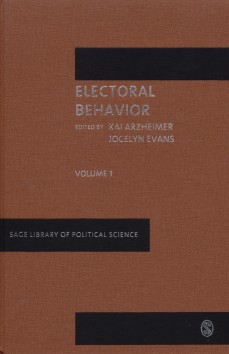Library of Electoral Behaviour: Introduction and Overview
Introduction: Electoral Behaviour

The history of the scientific study of voting behaviour (or psephology) goes back almost a hundred years, but as an important and often vibrant subfield of political science, it only took off during the "behavioural revolution" after the Second World War. Today, the field is well established and is considered part of the "core business" of political science, enjoying links with other subfields as diverse as party systems, European studies, and political theory. Moreover, the study of voting behaviour is very much an interdisciplinary exercise: Three of the most influential approaches to the study of voting behaviour that inform the way political scientists think about voting behaviour up to the present date - Lazarsfeld, Berelson, and Gaudet (1944), Campbell et al. (1960), and Downs (1957) - borrow their fundamental concepts from sociology, social psychology, and economics respectively.
As a whole, the study of electoral behaviour is (with a few notable exceptions) firmly grounded in methodological individualism, i.e. the idea that individual human actions constitute the elementary unit of analysis (Elster 1989). Macro-phenomena like turnout rates or vote shares for a given set of parties are obviously the outcome of millions of individual decisions, which are then aggregated according to the rules of the electoral system. While other variables at the macro-level (the rate of unemployment, the party system, media coverage of the incumbent government, inter alia) may have an impact on these individual acts, it is next to impossible to conceive of a causal link between two macro-level variables - say, the share of workers in the electorate and electoral support for a socialist party - that completely bypasses what happens at the level of the individual (Coleman 1994). Even André Siegfried (1913) who at the very beginning of electoral geography famously identified a connection between the type of soil the voters live on and the returns for conservative parties, acknowledged that the causal chain that links both variables is rather long and involves - among other things - the accumulation of capital and the exchange of ideas and information.
There is, however, disagreement over how individuals make political choices, and thus what the "micro-model" should look like. In principle, three general "Models of Man" can be distinguished. A first school of thought, in accordance with classical sociological thought, assumes that political behaviour is essentially regulated by group-specific norms. Consequently, socio-demographic variables such as class, gender, or education, should go a long way in explaining voting behaviour. A second account which relies heavily upon post-war social-psychological theories holds that political attitudes (which are nonetheless often group-specific) drive human behaviour. Adherents of this school consequently focus on the study of public opinion. Classic texts representing the core of these two approaches are assembled in volume 1 of this collection, and will be discussed in the first parts of this introduction.
A third account, however, that often goes under the label of "rational choice" assumes that voting is neither an unconditional response to the activation of social norms nor a semi-conscious reaction to political stimuli but rather an instance of goal-oriented behaviour employing the optimal means to achieve a given end. While its tenets may often seem highly unrealistic, the great strength of the approach is its clear deductive structure. This, in turn, allows one to account for the "bounded rationality" (Simon 1955) of real voters in a very systematic and reproducible way, by modifying the basic assumptions in some well-specified manner. In parallel fashion, the mainstream of social psychology has witnessed a "cognitive turn" in recent decades, which eventually reflected back on the application of the socio psychological model in voting studies. While "convergence" would still be too final a word, the contributions assembled in volume 2 clearly demonstrate that all three approaches are nothing like "incommensurable paradigms" in the sense of Thomas Kuhn, but rather should be seen as compatible narratives that highlight different aspects of the same causal story.
Volume 3 presents further evidence for the validity of this claim: from its very beginnings in the first decade of the 20th century, all approaches to electoral behaviour have reflected on the role of the context in which a vote is cast. While the spatial and temporal scope as well as the substantive nature of what is defined as "context" in the respective contributions varies considerably, the idea that context matters is one important commonalty between many otherwise very divergent research programs. Equally, the VP-function literature takes context even further, using macro- and meso-level variables as the basis for predictive models in the Holy Grail of psephology - electoral forecasting. This conceptual overlap notwithstanding, many of the discipline's main debates and controversies are far from resolved. While many of the articles in this collection can be seen as contributions to some debate, volume 4 brings together a number of papers that are a representative sample of the voices in the field's most lively discussions. These include both theoretical and methodological concerns, including meaning and measurement of party identification, the role of survey research in psephology and its replacement by field experiments and other non-survey approaches.
In many ways, methodological advances represent the most fruitful future avenues for research, given that the paradigms of voting have largely been exhausted. It is always dangerous to state that a field has been "defined", and certainly many of the increasingly scientific approaches to decision-making generally emanating from psychology and even neuro-science confirm that our understanding of cognitive processes is far from complete. But such research promises to nuance and deepen our existing broad-brush understanding of why people vote, rather than threatening to overturn it completely. To that extent, we are confident that the articles which follow will remain relevant to the discipline, having provided the signposts to explanation, if not the exact mechanics.
Want to read more? Buy the book!